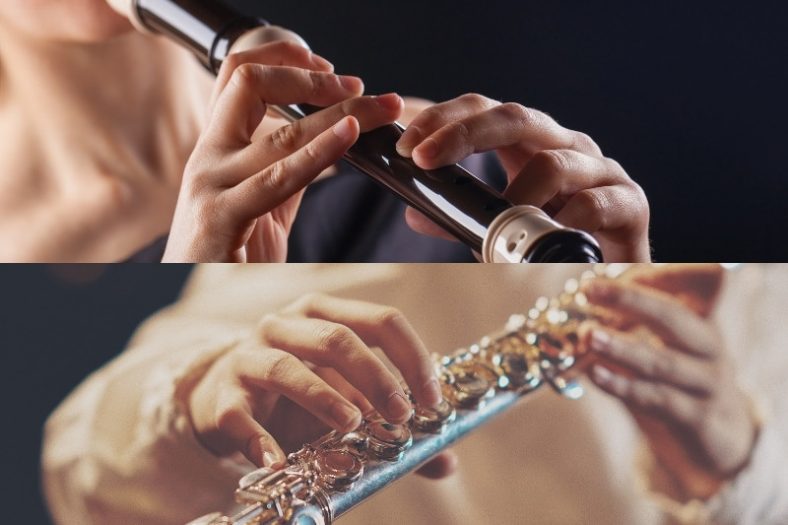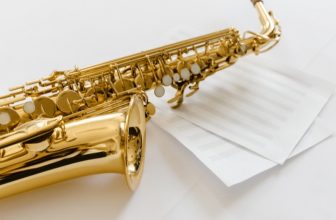Recorder vs Flute (What’s the Difference?)

A flute is a reedless instrument that uses the free airflow across its different openings to produce its sounds. On the other hand, a recorder is a woodwind instrument that uses a whistle mouthpiece to create its magic.
They’re both rod-shaped wind instruments and sound like a spring evening. That’s probably how most people would describe the flute and the recorder.
However, this couldn’t be further from the truth. The flute and recorder are very distinct instruments in their own right and we’re here today to take a look at how.
Both of these woodwind instruments are used heavily in orchestral arrangements today. Although, a recorder tends to be easier to learn than its counterpart. Many people consider it to be a pathway to the flute.
The two instruments have a lot of unique features, including their history. So, let’s get on with understanding them much better.
Contents
What is a Flute?
The term flute isn’t restricted to only one instrument. In fact, the flute is a family of woodwind instruments in itself. What sets them apart is that they are all reedless.
A flute in modern usage generally refers to the western concert flute. However, it is just one example of it. Piccolo, Alto flute, Bass flute, Bansuri, Dizi, and Pan flute are all variations of the flute from different eras and parts of the world.
Most flutes are played sideways. These are called side-blown or transverse flutes. There are also traditional flutes that are played vertically, known as end-blown.
Flutes produce their sound when the air flows through an opening. Flutists manipulate the sound by closing or opening several holes on their instruments. If you’re buying a flute, don’t focus on the metal it’s made of. Instead, look at its size and the shape of the head.
The flute is considered to be one of the oldest instruments in the world with its primitive models dating back to over 40,000 years ago. Over the years, it has found its niche in classical music as well as traditional folk music.
What is a Recorder?
A recorder is a type of flute that comes with a mouthpiece. It is a part of the internal duct flute family or the fipple flutes.
A recorder is played vertically as its windway or the mouthpiece opening is located at the top. The sound production on the recorder is similar to that of a whistle, where a player blows into the instrument through its opening and a sweet, sharp sound comes out of the first window.
Recorders come in a variety of sizes. These sizes depend predominantly on vocal ranges. The Soprano, Alto, Bass, and Tenor are the primary types of recorders used today.
The oldest recorders were found in the middle ages. However, the recorder, as we know it today, came into prominence in the Renaissance era. This is why you’ll find recorders being playing in European music only.
In its early day, recorders were made of wood or ivory. As of today, there are many beginner recorders made of molded plastic.
Similarities
While distinct, the flute and recorder do share some common ground. This is understandable since they’re on the same spectrum of musical instruments.
They’re both woodwind instruments that share the purpose of creating sweet, melodious music. To an untrained ear, their airy sound can seem interchangeable.
They are also heavily used in western classical music. Although, the flute is also played in the traditional music of other countries such as India, China, Japan, etc.
Despite the flute being much older, its contemporary versions share a similar lineage to the recorder. They are similar in design, aerodynamics, and the way they produce their sound, which is basically air flowing through the hollow body, vibrating throughout, and bending according to the hole uncovered.
Even the fingering is quite similar. This is why many teachers feel that learning one instrument is a pathway to the other.
Differences
This is where you’ll see the flute and the recorder go their separate ways. And why the recorder is considered a beginner instrument.
One big difference between the two is their playing position. While flutes are played sideways, recorders are played vertically.
The working of both instruments may be similar, but there are some stark differences as far as the design is concerned. Recorders are much smaller with a soprano recorder being around 12 inches long. Flutes can be as big as 26 inches.
Recorders have a duct hole present for the thumb and are limited to seven finger holes. Modern concert flutes can have up to 16 or 17 holes or keys. Flutes also lack a wedge to split the air. This gives flutists more control over the sound they want to produce.
Another big difference is the material that the two instruments are made of. Recorders are made of wood or molded plastic, making their tone simple, but light. Concert flutes, on the other hand, are made of metal, giving them much more control and character.
Flutes also have much better dynamic control. Recorders tend to be quieter, while the sound of flutes is dependent on the player.
Flutes also have a wider pitch range. They are capable of playing in the 3-octave range whereas baroque recorders are only limited to 2-octave and a tone. These are the reasons why flutes are preferred much more over recorders, although there are times when a recorder is more appropriate.
Flute and recorder players you should know about
Both the flute and the recorder are such sweet instruments that it’s always a good time to hear a tune. So, whether you’re a player yourself or simply want to explore music, here are some flute and recorder players that you should listen to:
- James Galway
- Georges Barrere
- Jean-Pierre Rampal
- Jean Baxtresser
- Jasmine Choi
- Hariprasad Chaurasia
- Matt Molloy
- Frans Bruggen
- Michala Petri
You can also find some flutes and recorders in pieces from Monteverdi, Vivaldi, Bach, and Handel.
Summary
The flute and recorder are two very beautiful woodwind instruments that are a pleasure to play and listen to. Being from a woodwind family, they have a lot in common. Even so, they share plenty of differences, which make them two very distinct instruments.
The flute is considered to be a more polished instrument. But it is played similarly to the recorder. This is why you’ll see many musicians play both.





